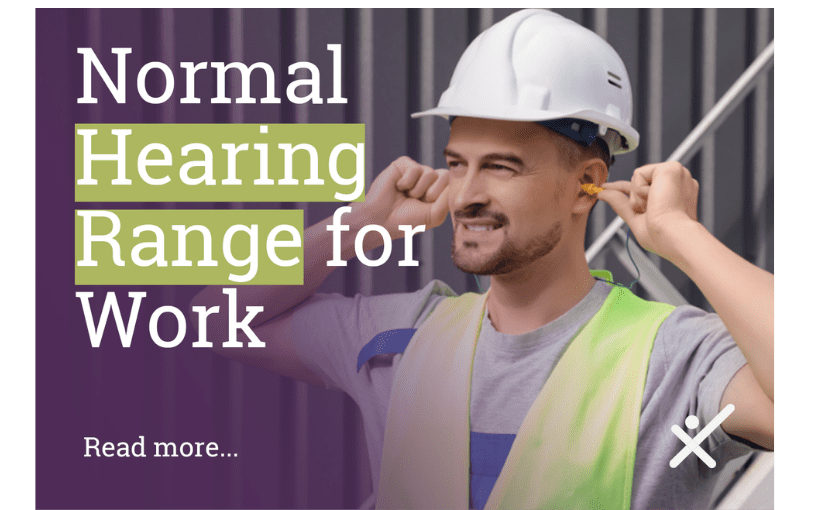
A great question arose during the job analysis section of our 2-day pre-conference workshop on Cutting Edge MSD Prevention Strategies, at ASSP 2025 in Orlando last month. One of the course participants asked:
“When doing a job analysis, how do we quantify the hearing requirements necessary for work?”
At ErgoScience, we primarily evaluate the physical demands of work (lift, carry, push, pull, squat, reach, etc.) and the worker's correlating physical abilities. We are not typically involved with evaluating the job's hearing requirements or measuring the worker’s hearing abilities.
However, as job analysts, we must be knowledgeable about hearing requirements for work if this topic arises regarding job accommodation, hiring job applicants, or making return-to-work decisions. The answer to this question also provides information that could be included in a job analysis report if the employer wishes to be specific regarding the hearing requirement for their jobs.
Hearing normal speech is important to most jobs that involve communication, which is the majority of jobs. Hearing could be particularly important in work environments where hearing alarms can mean life or death.
On some job analysis forms, the job analyst is asked to determine if hearing is within speech range and/or if hearing within all ranges is required for the job. Two corollary questions arise:
Answering these questions is one of the few times in job demands analysis where we must rely on normative data.
The ability to hear is measured in decibels (dB HL). Adequate hearing for speech is defined as the quietest sounds a person can hear across a range of frequencies that are important for understanding speech. The ability to hear is tested within 250 Hz to 8000 Hz, which covers most speech sounds. If someone has thresholds of 0–20 dB HL at all tested frequencies, they are considered to have normal hearing. They should be able to:
Another issue related to safety and hearing at work is the ability to hear an alarm in an industrial environment. To hear an alarm in an industrial environment, a person must have hearing sensitive enough to detect sounds significantly louder than normal conversation. Industrial alarms are designed to cut through high ambient noise levels (often 85–100 dBA or more).
The typical Industrial Alarm has:
The duration can be continuous or pulsed to attract attention, including tonal, broadband noise, or voice alarms.
If someone has a hearing loss greater than 40 dB HL at key frequencies, they may not reliably detect alarms over industrial noise without amplification or accommodation.
The chart below indicates the thresholds for normal hearing
Example:
Let’s say the ambient noise in a plant is 90 dBA, and the alarm is set at 105 dBA:
Despite the importance of adequate hearing for work, some settings lend themselves to accommodation. Table 1 below indicates the various categories of accommodations, how they work, and the best use cases for each.
Table 1.
| Category | Accommodation | How It Works | Best Use Cases |
| Communication Aids | Assistive Listening Devices (ALDs) | FM, infrared, or Bluetooth systems transmit speech directly to hearing aids/cochlear implants. | Meetings, training sessions, and one-on-one conversations in noisy environments. |
| Real-Time Captioning (CART) / Speech-to-Text Apps | Converts spoken words into text instantly on a screen or mobile device. | Large meetings, webinars, safety briefings, and training. | |
| Sign Language Interpreters | In-person or video remote interpreting for spoken communication. | Trainings, disciplinary meetings, and interviews. | |
| Visual & Tactile Alerts | Visual Alarm Systems | Strobe lights flash for alarms, machinery alerts, or forklift proximity. | Emergency systems, noisy production floors. |
| Tactile Alerting Devices | Wearable devices that vibrate for alarms or messages. | Emergency notification, time-sensitive task changes. | |
| Digital Dashboards/Monitors | On-screen pop-ups for equipment or process alerts. | Control rooms, manufacturing floors. | |
| Environmental Modifications | Quiet Meeting Spaces | Reduced background noise improves comprehension. | Performance reviews, training, problem-solving sessions. |
| Improved Lighting | Ensures clear visibility for lip reading and visual cues. | Offices, meeting rooms, shop floor stations. | |
| Acoustic Treatments | Noise-absorbing materials reduce interference from background sounds. | Break rooms, meeting spaces, training rooms. | |
| Procedural Changes | Written Instructions & Job Aids | Clear, visual documents for tasks and safety procedures. | Any recurring task or safety protocol. |
| Visual Pre-Shift Briefings | Use whiteboards or projected slides to summarize spoken updates. | Start-of-shift meetings, daily production goals. | |
| Buddy System | Assigns a co-worker to relay important information. | Emergency situations, dynamic work environments. | |
| PPE & Safety | Hearing-Protection-Compatible Devices | Earmuffs or plugs designed to work with hearing aids. | High-noise environments where speech comprehension is still needed. |
| Emergency Drill Modifications | Incorporates visual/tactile alerts for evacuation or shelter-in-place instructions. | Fire drills, severe weather drills, and chemical spill protocols. |
To hear normal speech, a worker must have hearing within the thresholds of 0–20 dB HL at all tested frequencies. To hear alarms safely in industrial environments, a worker’s hearing thresholds should ideally be:
Accommodations available for workers with hearing loss include modified PPE, procedural changes, environmental modifications, visual and tactile cues, and communication aids. Selection depends on the use case for which they are intended. Workers with greater hearing loss may need visual alarms, vibrating alerts, or amplification devices.

Share:
We'd Love to Chat!
ErgoScience makes the workplace better by applying evidence-based injury prevention through proven, defensible methodologies.


Proudly built by Adam Black Media Copyright © All rights reserved.
Our goal is to help people in the best way possible. this is a basic principle in every case and cause for success. contact us today for a free consultation.